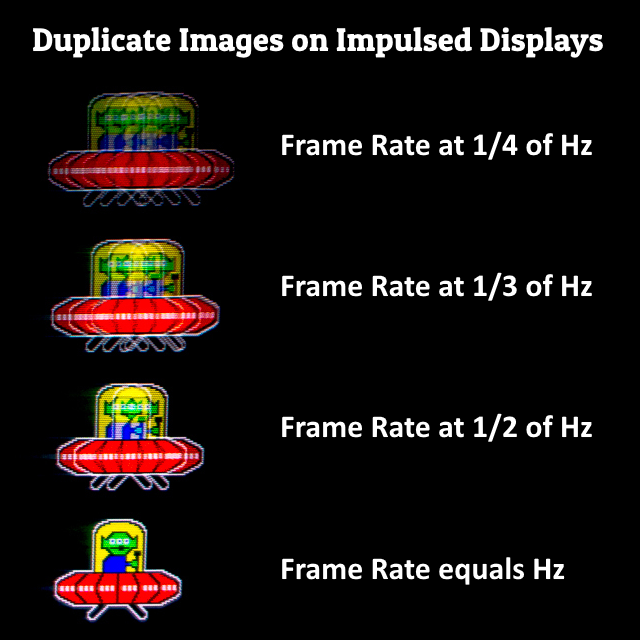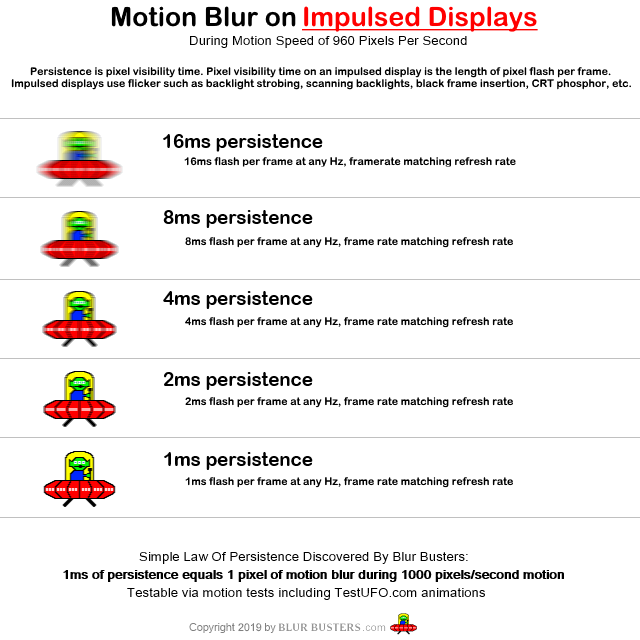RedCloudFuneral wrote: ↑04 Oct 2020, 06:11
How do VR headsets deal with variable framerates in a technical sense? They don't have the ability to vary the speed they strobe like some ASUS monitors right?
I know it's subjectively bad(just got out of a VR game which doesn't lock to hz or 1/2 hz) but why? Is the theory the same as with desktop displays?
Are you using an underpowered VR rig, or did you find a buggy VR game that had a stutter tantrum?
I don't have that problem with >98% of my VR games unless I use too extreme settings, so your experience is different from my experience. If your friend slapped together a VR rig out of a GTX 970 and loaded VR games at default settings, you may get insta-nausea.
VR games are often designed with a minimum baseline graphics card (such as a 970 or a 1080) to almost guarantee no frame drops with moderate settings in most VR games. Developers use advanced frame pacing debugging tools & some use software such as NVIDIA VR Works, to debug frametime spikes so that approximately less than 0.01% of frametimes exceed refreshtimes (framerates going below VR refresh rates).
There are VR games I Play that has been framedropless almost to a five-nines guarantee (only 1 stutter noticed in 20 minutes), but it also helps I did not cheap out on my SSD (1TB Samsung 960 Pro in 2017 for $1,000 just near when it first came out).
So good VR games are among the most stutter-debugged software you can play, though I do not recommend anything less than approximately a 1080 Ti with a Rift (lower rez), or a 2080 with a Vive Pro (high rez). Just call it a day and grab an RTX 3070 if you are playing VR, and if you dare to play VR on a laptop, don't settle for anything less than an RTX 2070 Mobile. You can get by with low detail on less, but why bother?
It's very possible Oculus development lifecycles has had better stutter-debugging tools than generic SteamVR games played on a low-quantity headset, so I can't share experiences with those. However, a good job was done with Half Life Alyx even with SteamVR headsets.
Play VR properly with a four-nines frametime guarantee above Hz.
Yes, your 0.01% frametimes should never be below Hz (except during level loading etc).
Yes, amazingly, many VR games are now capable of four-nines frametime=Hz guarantees (According to debugging tools). It's amazing; I wish this frametime debugging was done more often for non-VR games. The spectacular frametime debugging done for VR should be done more often for non-VR.
Since ~2017, I have had an Oculus Rift matched with a GTX 1080 Ti Extreme (desktop), and my RTX 2080 (Razer Blade laptop) keeps up well with VR too -- as long as I keep laptop plugged in with its 230 watt power brick and keep the laptop well ventilitiated. The old 1080's throughout the Blur Busters office will be replaced with at least 3070's and 3080's soon.
The most common problem is users raising detail level too high for their GPU. I had to dial back settings slightly for the GTX 1080 Ti Extreme, otherwise it really stuttered in certain highly-complex scenes (less than 10% of the game), then it looked like it was able to maintain a four-names framepacing guarantee.
If you aren't getting latest GPUs -- then don't overdo detail settings for VR games -- and if VR-ing a gaming laptop, always plug in the laptop -- and use SSDs to minimize texturestreaming-related stutters. At some point, some VR games are just not well optimized (uggg....).
RedCloudFuneral wrote: ↑04 Oct 2020, 21:48
RealNC wrote: ↑04 Oct 2020, 06:21
RedCloudFuneral wrote: ↑04 Oct 2020, 06:11
How do VR headsets deal with variable framerates in a technical sense? They don't have the ability to vary the speed they strobe like some ASUS monitors right?
No, they are fixed-refresh. I'm not aware of any VRR-capable headsets right now.
So that stuttery jerky look of a non locked(or compensated) framerate in VR is a prime example of this?

Correct.
Regardless of strobed or non-strobed, "framerate=Hz" is needed for reality simulation situations (Holodecks, VR, immersive simulators, etc).
- No double images in strobed situations
- No motion blur in low-framerate situations
- No stutters from framerate mismatched to Hz
Remember, these framerate-limitation-derived duplicate images are above-and-beyond LCD-GtG-limitation-derived "strobe crosstalk". So you can get 2 strong images (double-flash of same frame) and 1 faint image (strobed crosstalk)
If you hate all of that, one good route to go is the HTC Vive Index Pro with the TPcast add-on. It's OLED based and avoids the crosstalk issue.
However, some LCD VR headsets have extremely low strobe crosstalk, they do vary a fair bit between VR headsets.

